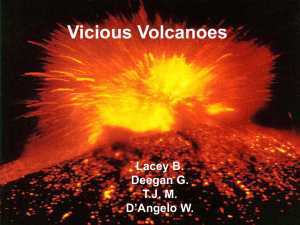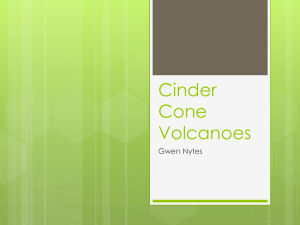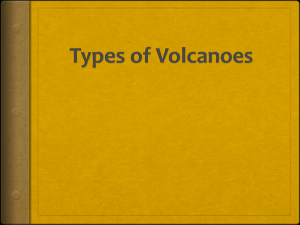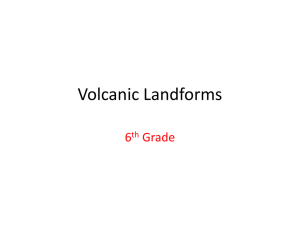MB_volcano_Presentation
advertisement
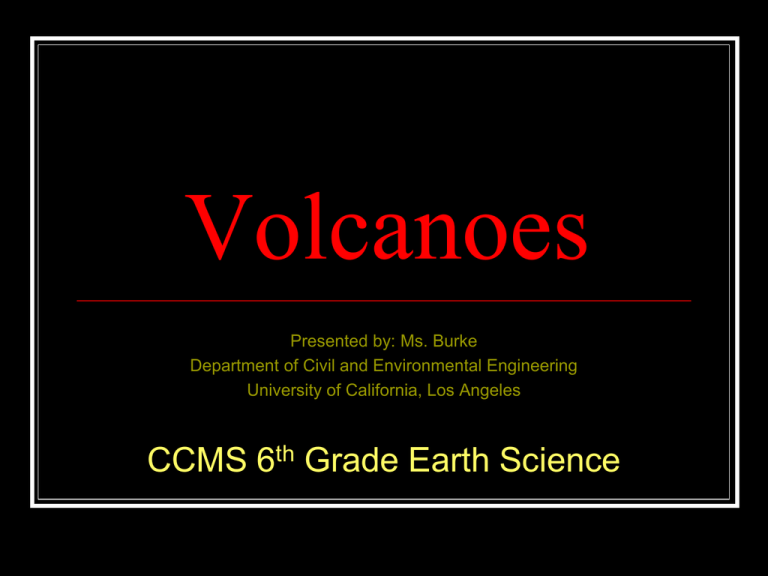
Volcanoes Presented by: Ms. Burke Department of Civil and Environmental Engineering University of California, Los Angeles CCMS 6th Grade Earth Science Eruption Videos Hawaii Kilauea Video http://video.google.com/videoplay?docid=5138291898525259472 &hl=en# http://www.youtube.com/watch?v=BicT13ecUbc http://www.facebook.com/video/video.php?v=1398777404573 Iceland First pictures from the new crater at Eyjafjallajök Volcanoes and Tectonic Plates Volcanic activity and the Earth’s tectonic plates Stratovolcanoes tend to form at subduction zones, or convergent plate margins, where an oceanic plate slides beneath a continental plate and contributes to the rise of magma to the surface. At rift zones, or divergent margins, shield volcanoes tend to form as two oceanic plates pull slowly apart and magma effuses upward through the gap. Volcanoes are not generally found at strike-slip zones, where two plates slide laterally past each other. “Hot spot” volcanoes may form where plumes of lava rise from deep within the mantle to the Earth’s crust far from any plate margins. * Map locations of volcanoes and the tectonic plates to see what patterns emerge Science Questions: Are most volcanoes located near edge or near the center of the tectonic plates? Are there certain types of plate boundaries where you are more likely to find volcanoes? “Ring of Fire”: type of plate boundary surrounding it?? most common type of volcano found there?? BIG QUESTION: Is there a connection between the type of plate boundary and the type of volcano found there? Using your map & the map on page 159: Label each type of plate boundary (convergent, divergent, transform) with a different color Label each type of volcano (composite, cinder cone, shield) with a different color Draw arrows at each boundary to indicate the direction of plate motion Create a legend for your map Shield Stratovolcano Cinder Cone (Composite) Types of Volcanoes (simple version) Why are there different types? They are made from different materials Recall the different types of plates: Oceanic Continental Are they made out of the same “stuff”? *Viscosity lab activity Viscosity: measure of a fluid’s resistance to flow Determined by the composition of the fluid (what it is made of) The oceanic and continental crusts have different compositions. Oceanic Crust is primarily Basalt Continental Crust is mainly Granite These materials have different densities when solid and different viscosities when molten Lava types and their viscosities: Relative Size of Volcano Types Shield Volcanoes (low viscosity) Shield volcanoes form from eruptions of flowing lava. The lava spreads out and builds up volcanoes with broad, gently sloping sides. The shape resembles a warrior's shield. Cinder Cones (medium viscosity) Cinder cones are very small cone-shaped volcanoes built from erupting lava that breaks into small pieces as it blasts into the air. As the lava pieces fall back to the ground, they cool and harden into cinders that pile up around the volcano's vent. Composite (high viscosity) Composite volcanoes are built from eruptions of lava and tephra that pile up in layers, or strata, much like layers of cake and frosting. These volcanoes form symmetrical cones with steep sides. Dome (super high viscosity) Lava domes are formed lava too viscous to flow far, so the lava piles over and around its vent. They grow largely by expansion from within. They often form in calderas of stratovolcanoes following large eruptions. Name that Volcano! Identify: Type Plate Tectonic setting Viscosity (high, medium, low) of the following volcanoes… Composite Mount Fuji, Japan Convergent boundary Cinder cones Hawaii In the summit basin of Haleakala, a massive shield volcano that makes up 75% of the Island of Maui. Shield Mauna Loa Volcano, Hawai`i. Hotspot Lava erupts from a fissure on Mauna Loa March 25, 1984. Lava dome Novarupta Volcano, Katmai NP, Alaska Convergent boundary Enormous explosive eruption in 1912 could be heard 750 miles away and shot ash 20 miles high. The Dome erupted in the caldera Cinder Cone Pu`u ka Pele, Hawaii Hotspot Erupted on Mauna Kea Volcano (sheild). Composite Mount St. Helens, Cascade Range, WA Convergent boundary Composite Mount St. Helens, Cascade Range, WA Convergent boundary After the volcano “blew its top” on May 18, 1980. Ash plume reached ~15 miles high. Most destructive U.S. eruption. 2005 Lava Dome In the Crater of Mount St. Helens, WA Convergent boundary Cinder cone Pu`u `O`o cone at Kilauea Volcano, Hawaii. Hotspot Composite Arenal Volcano, in Costa Rica Convergent boundary Composite Colima Volcano, Mexico. Convergent boundary Colima is the most historically active volcano in Mexico. Lava Dome (Obsidian flow) Long Valley Caldera, California. Caldera collapsed after a huge eruption 760,000 years ago, 50 times bigger than Mt. St. Helen’s. Domes formed in the caldera following a series of explosive eruptions in the Mono-Inyo Volcanic Chain. Cinder cone Pu`u `O`o cone at Kilauea Volcano, Hawaii. Hotspot Lava Dome Little Glass Mountain, Medicine Lake, CA (This is where I got the obsidian.) Cinder cone Little Lake, (Mohave Desert) California. Composite Mount Mageik Volcano, Katmai NP, AK Convergent Boundary Composite Santa Maria volcano, in Guatemala Convergent boundary Santa Maria had a huge eruption in 1902, (1.3 cubic miles of lava over 2 days). Cinder cone… and Shield Volcano Mauna Loa, Hawaii Hotspot Composite Mt. Rainier, WA. Convergent boundary Shield Mauna Kea volcano, Hawaii Hotspot Cinder Cone, Mojave Desert, CA Caldera of a composite volcano Crater Lake, Mount Mazama, OR Convergent boundary




